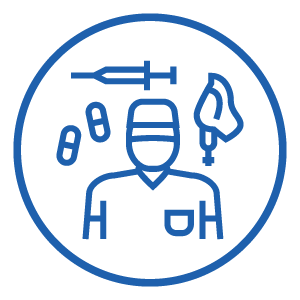 Anesthesiologists
Anesthesiologists
Hospitals redeploy surgical specialists to front lines to fight COVID-19
Editor's Note Specialists like cardiac and orthopedic surgical teams as well as anesthesiologists and cardiologists are being redeployed in hospitals to help treat the rising number of COVID-19 patients, the March 30 Modern Healthcare reports. What used to be the heart team at Manhattan’s Mount Sinai Morningside is now a…
Retired physicians, nurses, students being called back to work
Editor's Note California Gov Gavin Newsom is calling for retired physicians, nurses, and medical and nursing students to help staff emergency hospital sites, the March 30 Modern Healthcare reports. These sites could include the Los Angeles Coliseum and other sports arenas that will be converted to field hospitals to handle…
Case report: COVID-19 risk to healthcare workers
Editor's Note Of 41 healthcare workers who were exposed to aerosol-generating procedures for at least 10 minutes at a distance of 6.5 feet from a patient with severe pneumonia before he was diagnosed with COVID-19, none contracted the disease. The patient, a middle-aged man with diabetes and hyperlipidemia, was hospitalized…
Overcoming common obstacles to implementing a perioperative surgical home
Over the last 5 years, the perioperative surgical home (PSH) model has attracted increasing interest from OR directors, anesthesiologists, and surgeons. This team-based, patient-centered approach coordinates all phases of surgical care, from preoperative assessment through intraoperative care and postdischarge recovery. According to the American Society of Anesthesiologists, PSH initiatives have…
Study: Anesthetic management of patients with suspected COVID-19 during emergency surgical procedures
Editor's Note This retrospective, multicenter study from four hospitals in Wuhan, China, found that Novel Coronavirus 2019 (COVID-19) specific guidelines for emergency surgical procedures in patients with confirmed or suspected COVID-19 infection can effectively prevent cross-infection in the OR. The guidelines include: negative pressure ORs level 3 protective measures for…
FDA: Class I recall of King Systems’ video laryngoscope adapter
Editor's Note The Food & Drug Administration (FDA) on February 27 identified the recall by King Systems of its King Vision Video Laryngoscope Adapter (size ½) as Class I, the most serious. The recall was initiated because all devices from the affected lots show a reversed image on the display,…
Effect of AI early warning system for intraoperative hypotension
Editor's Note The use of an artificial intelligence (AI) early warning system, compared with standard care, resulted in less intraoperative hypotension in this preliminary study. This single-center, preliminary study from the Netherlands, which included 68 patients (intervention group, 34 and control group, 34) having elective noncardiac surgery, found that application…
Aviation-style, large-screen computerized checklist operated by anesthesia provider improves performance
Editor's Note The implementation of an aviation-style computerized surgical safety checklist displayed on a large, centrally located screen and operated by the anesthesia provider improved checklist performance in this study. A total of 671 cases were observed before and 547 cases after implementation of the computerized checklist system. The proportion…
Patients prefer checklists to be completed in front of them
Editor's Note Surgery patients overwhelmingly prefer pre-surgical safety checklists to be completed in front of them, contrary to what is thought by anesthesiologists, this Swiss study finds. In this trial, which included 110 anesthesiologists and 125 non-premedicated ear-nose-throat or maxillofacial surgery patients, the patients overwhelmingly agreed that anesthesiologists should use…
Patient, personnel, induction factors that affect OR start times
Editor's Note Though patient and personnel factors affect the order of case induction, induction time is most dependent on patient factors, this study finds. Of 15,823 cases analyzed, predictors of later patient induction included add-on case, ASA class 3 or more, neuraxial anesthesia, and CRNA staffing. In 11,093 (70.1%) cases,…

 Free Daily News
Free Daily News